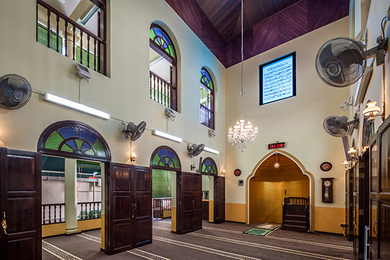Masjid Al Abrar Mosque

Tucked away in a corner of the Central Business District at Telok Ayer Street sits the Masjid Al-Abrar, one of the first mosques built in Singapore. The Masjid Al-Abrar did not always look like this – in 1827, it started out as a small thatched hut frequented by traders and money changers known as Chulias, Indian-Muslim worshippers from the Coromandal Coast of Southern India. Affectionately named Kuchu Palli (“Hut Mosque” in Tamil), the mosque became a place of spiritual refuge and communal gathering for these workers.
In 1850, the mosque was re-constructed with brick, and then underwent several major renovations between 1986 and 1989 – architectural updates, additional floors, and larger roofs were constructed to enlarge the prayer hall, resulting in the mosque in its current form.
Architecturally, the Masjid Al-Abrar is highly eclectic in form. At the exterior, distinct Indo-Islamic architectural styles can be seen. Two tall octagonal minarets, which have been present since the mid-nineteenth century, flank the main entrance. They are both crowned with Islamic symbols – a crescent moon and a star, setting the mosque apart from the shophouses in the vicinity.
The interior, meanwhile, features distinct European influences. European archways and Doric columns (ancient Greek in origin) line the entrance to the prayer hall. In the prayer hall, a blue-coloured glass window, etched with an inscription from the Quran high above the floor allows sunlight to shine through. With its high ceilings and cavernous space, the interior conveys a sense of awe and is suited for worshippers to congregate and perform religious rites.
Today, the Masjid Al-Abrar stands as one of Singapore’s national monuments and has a capacity of 500 – a far cry from its humble beginnings as a small thatched hut. Its expansion over the decades and eclectic architecture incorporated in the later years is a microcosm of how places evolve and adapt to the increasing needs of communities in our nation, all to create a better place for us to live.


